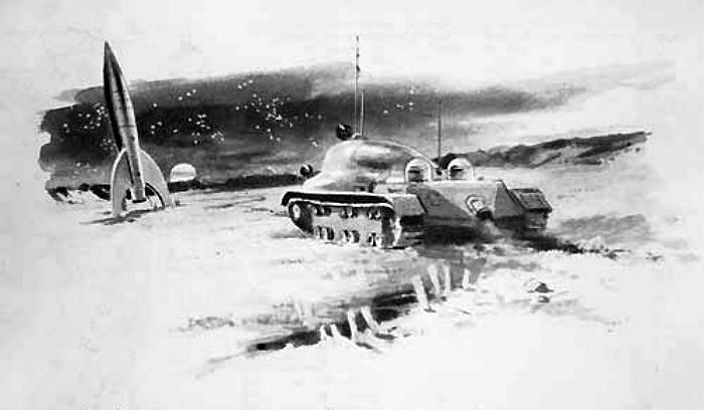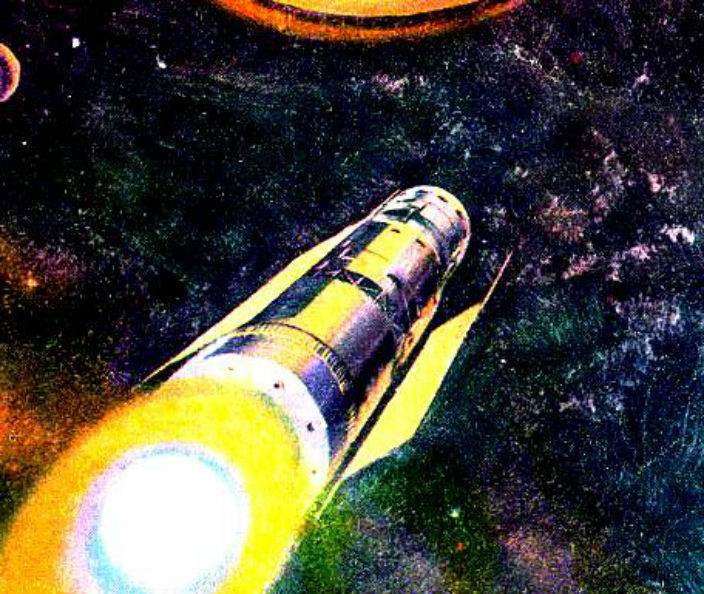
Science fiction writers were the pioneers of Mars exploration. In the early 1920s, Alexei Tolstoy wrote a novel about the socialist revolution attempt on Mars sparked by Soviet cosmonauts. In 1924, the novel was brought to the Silver screen.
Aelita, the Queen of Mars.
In February 1956, the Ogoniok magazine published a remarkable article by Boris Lyapunov with the prediction of the Soviet landing on Mars in 1995. His vision sounds a lot like the opening narration from the Star Trek original series:
Following the launch of an artificial satellite of our planet, the storming of skies has begun and the first lunar flight paved the way for piloted space flights, the author predicted. He even tried to describe the spacecraft, two years before the Sputnik and long before the world first saw Yuri Gagarin’s smile: “The Mars One spaceship is an engineering marvel of last quarter of the XX century. Engine, equipment, living conditions — everything adapted for the long journey with the landing on the planet.”
Best way to explore Mars according to Boris Lyapunov? The Martian rover, of course. “After first steps near the landing site, we shall go for a long trip by the rover… Let’s take an adequate supply of food, oxygen, and water. The cockpit of durable transparent plastic allows 360 degrees of visibility. The atomic engine provides the speed.”
In 1969 Soviet teen almanac I want to know everything predicted: “It is indisputable that before the end of this century, people will visit not only the Moon but the closest planets such as Mars and Venus.” Pretty sure nuclear spaceships would have something to do with it.
And then there was the engineer’s turn.
The Soviet Union considered the possibility of a manned flight to Mars even before Yuri Gagarin became the first man in space. One of these projects called Martian Piloted Complex (MPK) was being developed in 1956-1962. With its help, Soviet engineers hoped to send a six-man crew to Mars by 1975. The total weight would be around 1630 metric tonnes, almost four times heavier than International Space Station today.

Modern depiction by Mark Wade / Astronautix.com.
According to early white papers, the Martian Piloted Complex had to be constructed in low Earth orbit from parts delivered by a series of heavy N-1 rockets launches. These rockets were huge, standing 105 meters tall, and were developed to compete with NASA’s even taller Saturn V rocket designed by Wernher von Braun, the famous German-born mastermind behind the V-2 rocket and the Apollo program.
The N-1 became the last pet project of the genius chief engineer Sergei Korolev, who sent both the first artificial satellite and the first cosmonaut into space. The N-1 program, which he first envisioned as a Martian one and later adopted for the lunar race, was badly derailed after his sudden death in 1966.
After a successful landing on the Martian surface, the brave crew had to work there for a full year before launching back home on a spacecraft with a mass of 15 tonnes, about 10% of the initial weight.
Heavy Interplanetary Spaceship (TMK-1), the key element of another Martian project, was supposed to make manned non-stop flights to Mars and Venus. Two teams of engineers simultaneously developed the project. Konstantin Feoktistov led one team. In 1964, he even flew to space, although not to Mars, aboard the first Soviet three-man spacecraft, becoming the first civilian to make a space flight.

Drawing by Gleb Aleksushin / Astronautix.com.
Two projects were later merged into a joint venture. The first flight to Mars of the TMK-1 was planned to start on June 8, 1971, when the distance between Earth and Mars would be minimal.
Mission had to take three years, one month and two days: the landing was planned for July 10, 1974. However, the infamous Soviet planning failed: all four unmanned flight tests of the N-1 rocket ended up with failure. The Soviets lost the lunar race and scrapped plans to conquer the Red planet.
Ironically, the strengths of the Soviet regime, which allowed it to get ahead in the space race, doomed the Martian project. The complicity of decision-making, often changing goals and lack of a unified space agency led to the cancellation of flights to the Moon, Mars and other planets. Instead, the Soviet space experts focused on a perhaps less ambitious but no less complex program of colonization of the Earth’s orbit.
Sources:
1. Lost In Space by Greg Klerkx.
2. Russian Planetary Exploration: History, Development, Legacy and Prospects by Brian Harvey.
3. Encyclopedia Astronautica.